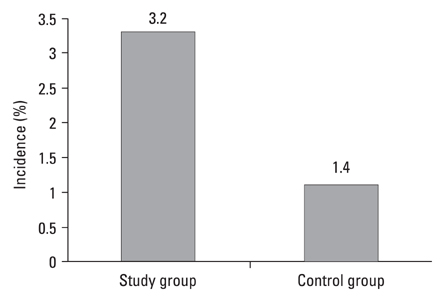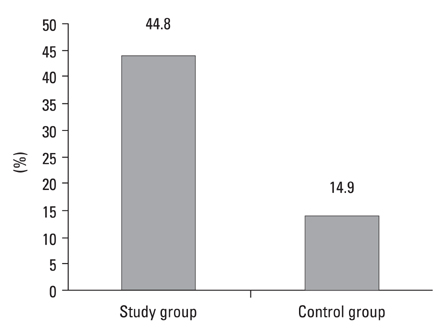Yonsei Med J.
2010 Mar;51(2):244-247. 10.3349/ymj.2010.51.2.244.
Urolithiasis in Patients Suffering from Malignant Hematologic Diseases
- Affiliations
-
- 1Department of Urology, College of Medicine, The Catholic University of Korea, Seoul, Korea. druroking@catholic.ac.kr
- 2Department of Urology, College of Medicine, Jeju National University, Jeju, Korea.
- KMID: 1126025
- DOI: http://doi.org/10.3349/ymj.2010.51.2.244
Abstract
- PURPOSE
We performed this study in order to evaluate the incidence and characteristics of urolithiasis in patients with malignant hematologic diseases.
MATERIALS AND METHODS
Nine hundred one patients who underwent medical treatment for malignant hematologic disease and 40,543 patients who visited the emergency room and without malignant hematologic diseases were included in our study. The patients with malignant hematologic diseases were divided into two groups depending on their primary treatment. Group I included patients with acute and chronic leukemia (AML, ALL, CML, CLL) for which chemotherapy and steroid therapy was necessary, and group II included patients with anaplastic anemia and myelodysplastic syndrome and who had undergone repeated transfusion for treatment. Comparisons were made between the two groups in respect to the incidence of urolithiasis and the stones' radiopacity.
RESULTS
Twenty nine patients (3.2%) of the 901 malignant hematologic patients were diagnosed with urolithiasis, compared to 575 patients (1.4%) of 40,543 emergency room patients. There was a significant increase of the incidence of urolithiasis in the malignant hematologic group. Compared to the general patients, the patients with malignant hematologic diseases had a higher rate of radiolucent stones (46.6% versus 16.3%, respectively), and the difference was significant.
CONCLUSION
The incidence of urolithiasis for malignant hematologic patients was significantly higher than that for the control group.
MeSH Terms
Figure
Reference
-
1. Leusmann DB, Blaschke R, Schmandt W. Results of 5,035 stone analyses: a contribution to epidemiology of urinary stone disease. Scand J Urol Nephrol. 1990. 24:205–210.
Article2. Howard SC, Kaplan SD, Razzouk BI, Rivera GK, Sandlund JT, Ribeiro RC, et al. Urolithiasis in pediatric patients with acute lymphoblastic leukemia. Leukemia. 2003. 17:541–546.
Article3. Curhan GC, Willett WC, Rimm EB, Stampfer MJ. A prospective study of dietary calcium and other nutrients and the risk of symptomatic kidney stones. N Engl J Med. 1993. 328:833–838.
Article4. Hesse A, Siener R. Current aspects of epidemiology and nutrition in urinary stone disease. World J Urol. 1997. 15:165–171.
Article5. Kim SC, Moon YT, Hong YP, Hwang TG, Choi SH, Kim KJ, et al. Prevalence and risk factors of urinary stones in Koreans. J Korean Med Sci. 1998. 13:138–146.
Article6. Jabbour E, Ribrag V. [Acute tumor lysis syndrome: update on therapy.]. Rev Med Interne. 2005. 26:27–32.7. Hiçsönmez G. The effect of steroid on myeloid leukemic cells: the potential of short-course high-dose methylprednisolone treatment in inducing differentiation, apoptosis and in stimulating myelopoiesis. Leuk Res. 2006. 30:60–68.8. Rubin MR, Bilezikian JP. Clinical review 151: The role of parathyroid hormone in the pathogenesis of glucocorticoid-induced osteoporosis: a re-examination of the evidence. J Clin Endocrinol Metab. 2002. 87:4033–4041.9. Bolan CD, Greer SE, Cecco SA, Oblitas JM, Rehak NN, Leitman SF. Comprehensive analysis of citrate effects during plateletpheresis in normal donors. Transfusion. 2001. 41:1165–1171.
Article10. Pui CH, Roy S 3rd, Noe HN. Urolithiasis in childhood acute leukemia and nonHodgkin's lymphoma. J Urol. 1986. 136:1052–1054.
Article11. Jaing TH, Hung IJ, Lin CJ, Chiu CH, Luo CC, Wang CJ. Acute myeloid leukemia complicated with staghorn calculus. Jpn J Clin Oncol. 2002. 32:365–367.
Article12. Pietrow PK, Preminger GM. Wein AJ, Kavoussi LR, Novick AC, Partin AW, Peters CA, editors. Evaluation and medical management of urinary lithiasis. Campbell-Walsh Urology. 2007. Philadelphia: Saunders;1393–1430.



